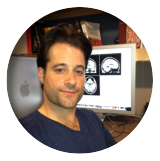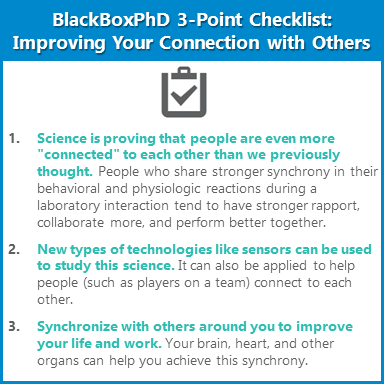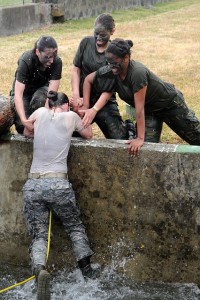
Kevin Bickart has been studying for a long time. And he’s still not done. He’s got a PhD in neuroscience, an MD, and going to start his residence at my grad school Alma Mater. He also loves technology. He’s not just smart, but he’s been studying some cool things about physiology, wearable devices, sports, and how the heart is even more tied to compassion and social connection than we thought. He’ll tell you about those things in this week’s interview.

Can you tell us your name, background, and what you’re working on lately?
My name is Kevin Bickart. I have been working on a combined MD/PhD degree at Boston University School of Medicine for the last 10 years. In that time, I ventured into the startup world of digital health and wearable sensing. I completed my PhD in anatomy and neurobiology in 2011 and will complete my medical training in May, a month from now. Next, I’Il move across the country to begin residency, first completing a year of internal medicine in San Francisco and then 3 years of neurology at Stanford.Generally, I am interested in studying previously unquantifiable factors thought to promote human thriving, such as the psychological and physiological makeup of people and the interpersonal dynamics between them. Over the years, I’ve used several different tools to investigate the brain and its impact on the body including MRI, wearable heart rate sensing, structured cognitive/behavioral interviews, and subjective reporting. With these tools, I’ve studied such things as the neuroanatomy of resilience and social networks as well as the psychophysiology of group dynamics and team chemistry.
Lately, I’ve been studying a phenomenon of group dynamic called synchrony. In this context, synchrony refers to moments when two or more people’s behavioral or physiological reactions mirror one another, or “sync up”. Prior scientific study has shown that people who share stronger synchrony during an interaction in the lab tend to have stronger rapport, collaborate more, perform better together, and enjoy a variety of other benefits outside the lab setting.
You got a PhD in neuroscience and now are working in sensors related to the heart. Is that a transition, or are those related?
It might seem that way, but neuroscience is actually quite a broad and interdisciplinary field encompassing the central and peripheral nervous systems, including its autonomic branch, as well as their impact on a variety of aspects of human experience. Heart rate is dynamically controlled by the 2 arms of the autonomic nervous system and varies over time in response to the challenges and demands perceived in the environment. For example during exercise or a perceived threat, sympathetic input to the heart increases thereby accelerating heart rate and increasing oxygen delivery to the brain and parts of the body. Because of its intimate connection with the brain, and the ease of measuring changes in heart rate, monitoring the heart enables researchers to gain valuable insight into the brain’s response to a variety of demands in the environment.
You mentioned that your research deals with synchrony. What do you mean by that?
In my most recent work, my colleagues and I analyzed the degree to which athletes’ heart rates varied together, or synchronized, throughout games and practices. From the prior work on synchrony in the lab setting, showing in many cases that synchrony promotes positive outcomes, we hypothesized that synchrony in athletes would promote better performance. In other words, synchrony would serve as an objective index of team chemistry, which to our knowledge did not exist.
In our preliminary analyses, we found that indeed, athletes who share heart rate synchrony with more of their teammates tended to play better. And, if there was a question about what heart rate synchrony was really measuring, we also found that athletes who synced up with the most teammates were rated by their coaches as having the most positive teamwork behaviors, ratings that were blind to measures of synchrony. Given these findings, it would seem that heart rate synchrony may be a valid and objective measure of team chemistry. Furthermore, that team chemistry does indeed predict better performance.
This could have far-reaching implications, not just in sport, but for many other types of teams. It could be especially important in teams under greater pressures with more dire outcomes, such as teams in military, medicine, and first response. Synchrony as a proxy for chemistry could also be used in lighter contexts too. It could be used to objectively quantify the compatibility between potential partners or recruits and their potential colleagues.
We typically talk about the heart as the center of love or compassion. Are you saying there’s some scientific evidence for that?
Perhaps I’m saying the brain is, actually. But certainly the signal we are measuring from the hearts of teammates may be a proxy for such interpersonal characteristics as love and compassion. A concept in psychology termed empathic accuracy has been studied in this way. For example, studies on empathic accuracy show that people who synchronize more strongly with the behavioral and physiological reactions of another person tend to better predict what emotion that other person is feeling.
What insights has your research given you about teams, or people in general?
I think the work is still exploratory but to me, the implications are promising and exciting. I think one day people will be able to use real-time measurements of synchrony to gauge whether they are in line or compatible with others they are interacting with, and ultimately, modify their behavior to improve the interaction. This would be akin to types of biofeedback that are used today on an individual level for such things as stress management. Only synchrony would be used on an interpersonal level for social and group interactions.
Before we can apply this science and technology though, perhaps there is a poor man’s version of synchrony monitoring that can be useful in practice today. Mindfulness, for example, could serve as a poor man’s version of this social biofeedback, until science and technology catch up. In other words, today people can become mindful of the sensations that arise in reaction to others around them, and in so doing modify their behavior for more effective collective outcomes. We do this without knowing already, by for example, synchronizing our body language in interviews when we are on the same page with our interviewer. Making this a conscious effort could help us to build better rapport and develop stronger empathy and compassion for those we must connect with as we go about our work.

Pingback: Kata Kata Ucapan Lebaran Idul Fitri 2017/2018
Pingback: pax 3 auto shut off
Pingback: 123movies
Pingback: sscn.bkn.go.id 2017
Pingback: Togel Tokyo Harian
Pingback: Funny cats
Pingback: Boliden
Pingback: agen judi bola
Pingback: bet535 casino
Pingback: hop over to this site
Pingback: حاصل على شهادات عالمية من الويبوماتركس
Pingback: real estate leads
Pingback: ppc optimization
Pingback: ppc services in usa
Pingback: marriage organizers in hyderabad
Pingback: 먹튀검증
Pingback: __p
Pingback: Mp3 Music Download
Pingback: satta matka, satta king, satta, matka, kalyan matka
Pingback: Array Questions
Pingback: Tesla Sucks
Pingback: In Vitro ADME Studies
Pingback: Heena Khan Bangalore Escorts
Pingback: Ambika Ahuja Jaipur Escorts
Pingback: JAIPUR ESCORTS ALIYA SINHA
Pingback: BANGALORE COMPANION ESCORTS
Pingback: Dhruvi Jaipur Independent Escorts
Pingback: JAIPUR ESCORTS MODEL DRISHYA
Pingback: Jiya Malik High Profile Jaipur Escorts Model
Pingback: FUN WITH JAIPUR ESCORTS PUJA KAUR
Pingback: XXX BANGALORE ESCORTS ROZLYN MODEL
Pingback: Selly Arora Independent Bangalore Escorts
Pingback: Enjoy With Jaipur Escorts Tanisha Walia
Pingback: RUBEENA RUSSIAN BANGALORE ESCORTS
Pingback: Bristy Roy Independent Bangalore Escorts
Pingback: Bangalore Escorts Sneha Despandey
Pingback: jake burgess springfield mo
Pingback: forex signals
Pingback: Ruby Sen Kolkata Independent Escorts
Pingback: Diana Diaz Goa Independent Escorts Services
Pingback: Diksha Arya Independent Escorts Services in Kolkata
Pingback: Devika Kakkar Goa Escorts Services
Pingback: Rebecca Desuza Goa Independent Escorts Services
Pingback: Yamini Mittal Independent Escorts Services in Goa
Pingback: Simmi Mittal Kolkata Escorts Services
Pingback: Kolkata Escorts Services Ragini Mehta
Pingback: Navya Sharma Independent Kolkata Escorts Services
Pingback: Elisha Roy Goa Independent Escorts Services
Pingback: Alisha Oberoi Kolkata Escorts Services
Pingback: Divya Arora Goa Independent Escorts Services
Pingback: Simran Batra Independent Escorts in Kolkata
Pingback: Ashna Ahuja Escorts Services in Kolkata
Pingback: Sofia Desai Escorts Services in Goa
Pingback: Mayra Khan Escorts Services in Kolkata
Pingback: Goa Escorts Services Drishti Goyal
Pingback: Eva J Law Independent Goa Escorts Services
Pingback: Fiza Khan Kolkata Escorts Services
Pingback: bitcoin casino
Pingback: Sruthi Pathak Escorts in Bangalore
Pingback: Ambika Ahuja Jaipur Escorts Services
Pingback: Bangalore Escorts
Pingback: Sruthi Pathak Bangalore Female Escorts
Pingback: Sruthi Pathak Bangalore Escorts Services
Pingback: Trully Independent Bangalore Escorts
Pingback: Trully Independent Bangalore Escorts Services
Pingback: Fiza Khan Kolkata Independent Call Girls Services
Pingback: Ruchika Roy Kolkata Escorts Call Girls Services
Pingback: Fiza Khan Kolkata Independent Escorts Call Girls Services
Pingback: Fiza Khan Kolkata Call Girls Escorts Services
Pingback: Diksha Arya Kolkata Escorts Call Girls Services
Pingback: Diksha Arya Kolkata Independent Escorts Call Girls Services
Pingback: website
Pingback: Cheap
Pingback: Nidika Offer Call Girls in Bangalore
Pingback: Pune Escorts Services Call Girls
Pingback: Bangalore Cheap Escorts Sevices
Pingback: Goa Escorts Call Girls Services
Pingback: Bangalore Escorts Services
Pingback: sildenafil kamagra
Pingback: mnebrzyd
Pingback: how fast does azithromycin work for chlamydia
Pingback: amoxicillin buy online
Pingback: furosemide pills 20 mg
Pingback: z pack azithromycin
Pingback: stromectol ivermectin
Pingback: albuterol 8.5 g
Pingback: synthroid directions
Pingback: propecia price costco
Pingback: neurontin taper
Pingback: metformin dementia
Pingback: plaquenil guidelines 2018
Pingback: amoxil 875
Pingback: furosemide iv
Pingback: gabapentin 500 mg
Pingback: plaquenil 50mg
Pingback: prednisone 20 mg pill
Pingback: buy priligy
Pingback: buy modafinil canada
Pingback: ivermectin cream 1
Pingback: ventolin discount
Pingback: zithromax buy online
Pingback: cheap furosemide
Pingback: neurontin 330 mg
Pingback: plaquenil 400mg
Pingback: prednisone 50 tablet
Pingback: stromectol pill price
Pingback: ventolin tablets uk
Pingback: molnupiravir india